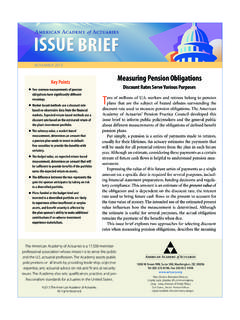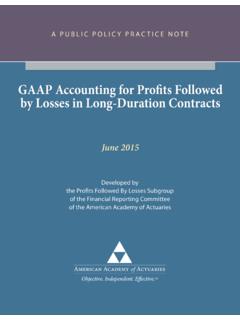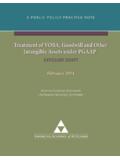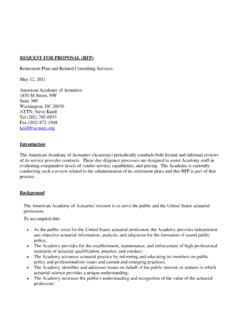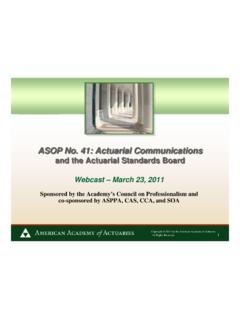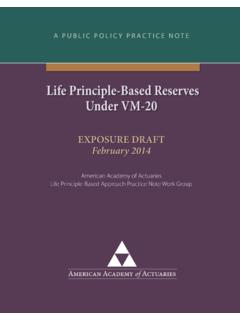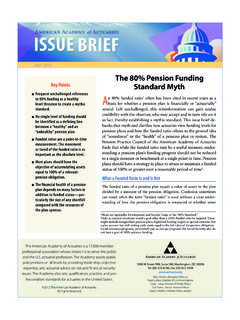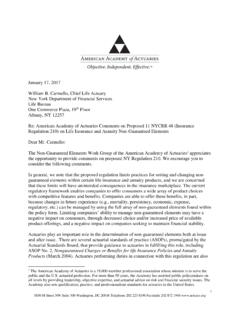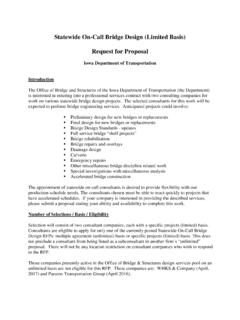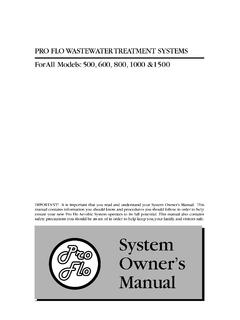Transcription of CounCil on Professionalism - American Academy of Actuaries
1 1850 M Street NW, Suite 300 Washington, 20036202-223-8196 FAX of Interest When Doing Volunteer WorkCounCil on Professionalisma Professionalism DisCussion PaPerA Professionalism DISCUSSION PAPER 2011 American Academy of Actuaries . All rights reserved. The American Academy of Actuaries is a professional association with over 17,000 members, whose mission is to assist public policymakers by providing leadership, objective expertise, and actuarial advice on risk and financial security issues. The Academy also sets qualification, practice, and Professionalism standards for Actuaries in the United States.
2 1850 M Street , Suite 300 Washington, 20036-5805 CONFLICTS OF INTEREST WHEN DOING VOLUNTEER WORK American Academy OF Actuaries 1 The purpose of this paper is to help Academy members identify any actual or potential conflicts of interest they might have as an Academy volunteer, and to suggest what actions might be considered to address such conflicts. Specifically this paper covers: What is a conflict of interest? How does the Code of Professional Conduct apply to an Academy volunteer? What actions should the volunteer take if a conflict of interest exists?
3 What is a Conflict of Interest? Conflict of interest is a term used in different contexts with different meanings. It seems obvious, but can be frequently elusive. Put simply a conflict of interest is an interest that prevents, or could prevent, a person from performing some task objectively. A straightforward example of a conflict of interest is that of a judge who is related to someone appearing before him. In such a situation the judge would disclose the relationship and recuse himself from the case. How does the Code of Professional Conduct apply to an Academy volunteer?
4 The American Academy of Actuaries Code of Professional Conduct states: Precept 7. An Actuary shall not knowingly perform Actuarial Services involving an actual or potential conflict of interest unless: A. the Actuary s ability to act fairly is unimpaired; B. there has been disclosure of the conflict to all present and known prospective Principals whose interests would be affected by the conflict; and C. all such Principals have expressly agreed to the performance of the Actuarial Services by the Actuary. Applicability of Precept 7 in a Classic Commercial Sense A classic commercial conflict of interest is caused by the existence of some circumstance outside the business relationship (such as a financial or personal relationship) that could affect the professional s judgment.
5 An example is a consulting actuary who has prepared an appraisal of an insurance company (the actuary s client) looking to sell itself where the actuary will benefit financially if the sale occurs. The interest might be caused by ownership of stock in the company, a contingent fee agreement, or some other circumstance that would create a conflict. According to Precept 7, the actuary should disclose his interest in the outcome to his client (the insurance company), secure its consent to do the work, and disclose the conflict of interest to any prospective buyer that is given the appraisal (the other Principal in this case).
6 Applicability of Precept 7 to an Academy Volunteer Precept 7, although it did not specifically consider volunteer work when it was created, can be interpreted to mean that when a volunteer performs work for the Academy , the CONFLICTS OF INTEREST WHEN DOING VOLUNTEER WORK American Academy OF Actuaries 2 Academy may be considered the Principal whose interests could be affected by any conflict of interest. Since one aspect of the Academy s mission is to provide, independent and objective actuarial information, analysis, and education for the formation of sound public policy, the Academy needs to be able to rely on the input from its committees to be able to support that mission, and the committees, in turn, need to be able to rely on the volunteers that make up the committees.
7 This would mean that if a volunteer had an actual or potential conflict of interest with respect to that mission, they would be required to disclose that conflict to the other members of the committee ( disclosure of the conflict to all present and known prospective Principals whose interests would be affected by the conflict from Precept 7), provided such disclosure would not cause the volunteer to violate confidentiality or other prohibitions on disclosure, and secure consent to participate in the committee s work. In the event the volunteer would be precluded from disclosure because of confidentiality or other prohibitions, the volunteer should recuse himself from participating in the committee work for which he is potentially conflicted.
8 What actions should the volunteer take if a conflict of interest exists? A typical situation with Academy volunteers involves serving on a work group that is developing recommendations to assist a governmental or quasi-governmental body on actual or model laws and regulations. A volunteer who is an employee of, or a consultant for, a company that will be affected (beneficially or adversely) by the model laws and regulations has at least a potential conflict of interest. To the extent that such proposed legislation affects the industry in general, no disclosure is necessary, since the potential conflict of interest is understood by the members of the committee, whose goal it is to come up with an objective analysis and recommendation.
9 But if any member of the committee works for a firm or has clients that would be more severely impacted by the proposal than the industry in general, this should be disclosed to the other members of the committee. His disclosure gives the other members of the committee an opportunity to consider his views in the appropriate context. Consider the example of a consulting pension actuary on the Pension Practice CounCil , who is preparing a response to proposed regulations on funding tax-qualified pension plans. The consulting pension actuary's primary clients are very large, long-established manufacturing companies with super-mature pension plans.
10 The consulting pension actuary has been told, as part of his consulting assignments, that any increases in funding requirements would likely tip the companies into bankruptcy. The proposed regulations would require large increases in contributions putting his clients, and his own revenue stream, at risk. The actuary in this example would have the choice of disclosing the additional information to the Pension Practice CounCil ( , that the impact to the particular client segment that he consults for could be impacted to the point that some companies could be tipped into bankruptcy) or recusing himself from the work of developing the Academy response.
